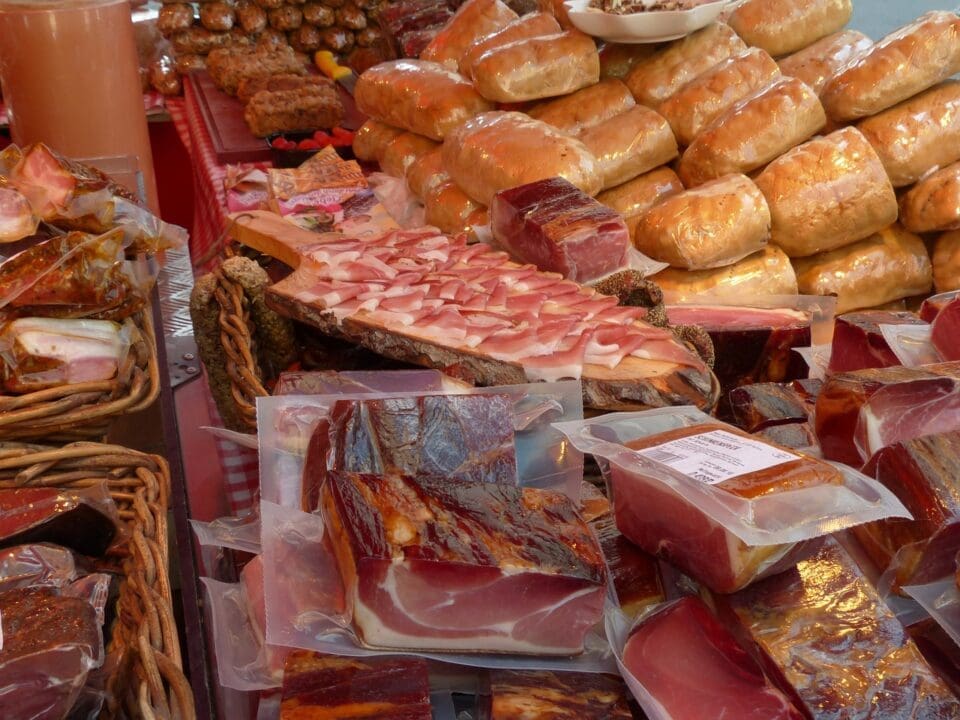Cured meats have long been a staple in human diets, offering both a flavourful culinary experience and a practical method of food preservation. Dating back thousands of years, the practice of curing meat has evolved from a simple necessity to an art form cherished by food enthusiasts worldwide. Let’s delve into the fascinating history of cured meats and how this age-old process has become an integral part of our gastronomic heritage.
The Origins of Meat Curing
The art of curing meat began as a solution to one of humanity’s greatest challenges: food preservation. Before refrigeration, early civilisations needed methods to prevent their food from spoiling, especially in times when fresh meat was unavailable, like during the winter months or long journeys.
The oldest known evidence of meat curing dates back to ancient Mesopotamia and Egypt around 3000 BCE. These early societies discovered that salt, an abundant and valuable commodity at the time, could draw moisture out of meat and inhibit the growth of harmful bacteria. This primitive form of curing involved rubbing the meat with salt, allowing it to dehydrate and preserve. This method was soon combined with smoking, another technique that extended the shelf life of meat.
Cured Meats in Ancient Civilisations
As human society progressed, so too did the techniques of meat curing. The ancient Greeks and Romans made significant contributions to the development of curing methods. The Romans, in particular, excelled in the art, preserving not only meat but also fish with salt and a process known as “salting in brine.” The salted products were highly prized and became central to the Roman diet, with cured ham (known as perna) being a favourite delicacy.
The Romans spread their curing techniques throughout the vast empire, and these methods reached as far as the British Isles, Gaul (modern-day France), and Spain. In these regions, local varieties of cured meats began to develop, influenced by the unique climates and available ingredients.
The Middle Ages: An Era of Tradition
The Middle Ages saw a flourishing of cured meat traditions across Europe. With the fall of the Roman Empire, local regions adapted the curing techniques passed down to them. In Italy, for example, the production of prosciutto and salami began to take shape, while in Spain, the curing of jamón (ham) became an integral part of the local food culture.
During this period, monasteries and abbeys played a crucial role in the preservation and advancement of curing methods. Monks, who often had access to large stores of salt, would cure meats as part of their self-sufficient way of life. These religious institutions became centres of knowledge, and their curing practices laid the groundwork for many modern varieties of cured meats.
The Renaissance and Exploration
The Age of Exploration in the 15th and 16th centuries marked a turning point in the history of cured meats. As European explorers set out on long sea voyages, they needed provisions that would not spoil during their journeys. Cured meats, thanks to their long shelf life, became an essential part of the diet for sailors and soldiers alike.
Spanish explorers in particular carried jamón with them on their voyages to the New World, introducing the practice of curing to the Americas. In return, explorers brought back new spices, such as paprika and pepper, which began to influence the flavour profiles of traditional European cured meats. These cross-cultural exchanges enriched the already diverse world of cured meats, leading to the development of new varieties such as chorizo, a paprika-spiced cured sausage.
Modern Innovations and Global Appeal
The Industrial Revolution in the 19th century brought about significant changes in the production and distribution of cured meats. Advances in transportation, refrigeration, and food processing allowed for mass production and export, making cured meats more accessible to a global audience.
Today, curing remains an integral part of food culture worldwide. Italy’s prosciutto di Parma, Spain’s jamón ibérico, France’s saucisson, and Germany’s bratwurst are just a few examples of the variety of cured meats enjoyed across the globe. The popularity of charcuterie boards has also helped to elevate cured meats into the realm of gourmet cuisine, where artisanal and traditional methods are celebrated.
The Art and Science of Curing
Curing meats is not just about preservation; it’s also about enhancing flavour. The process involves a delicate balance of salt, time, and often, the infusion of smoke, herbs, or spices. There are several types of curing methods:
- Dry curing: The meat is coated in salt, sometimes with additional spices, and left to cure in a cool, dry environment. This method is commonly used for products like prosciutto and jamón.
- Wet curing (brining): The meat is submerged in a saltwater solution, sometimes with sugar, herbs, or spices, and left to absorb the flavours. This is a popular method for ham and corned beef.
- Smoking: After the initial cure, the meat is smoked to add flavour and further preserve it. This method is commonly used for sausages, bacon, and fish.
